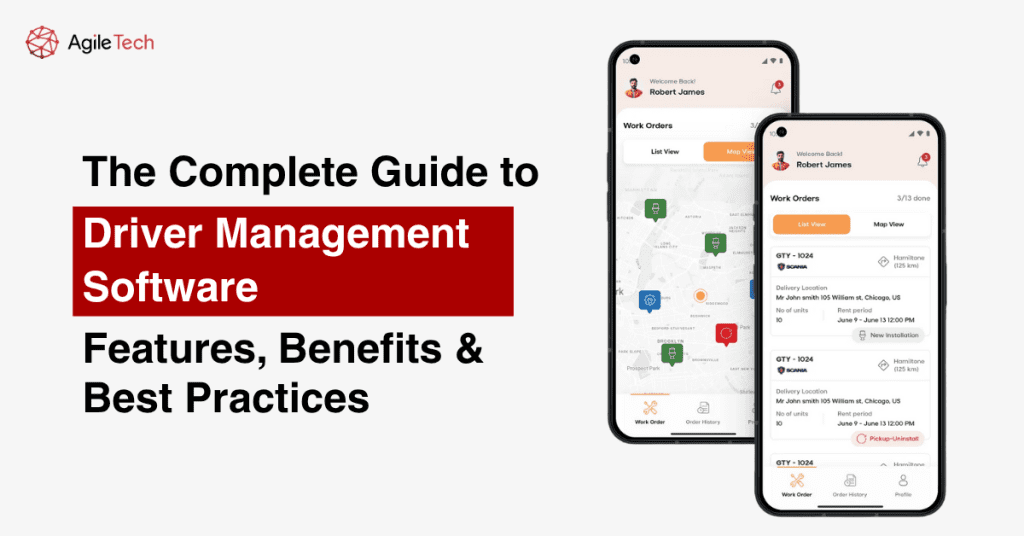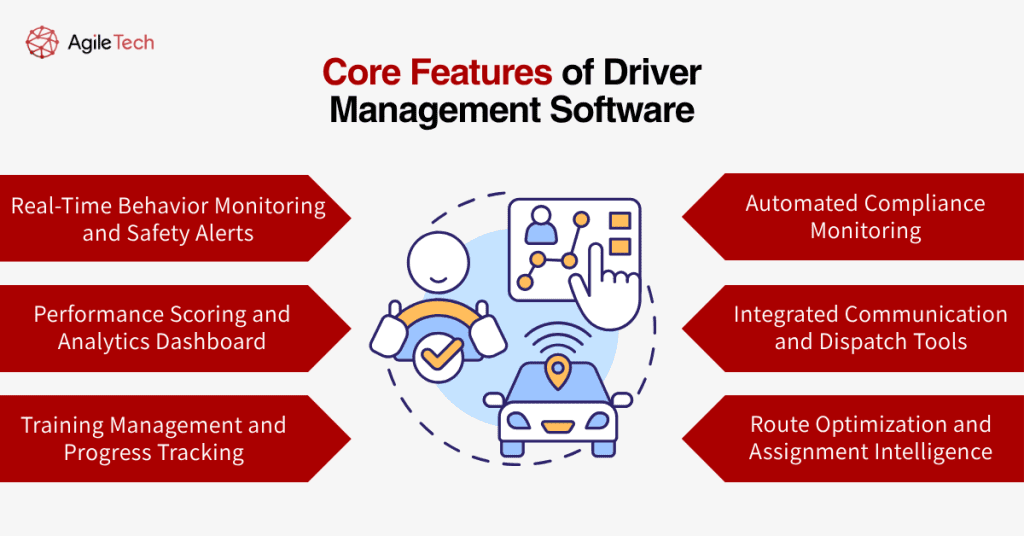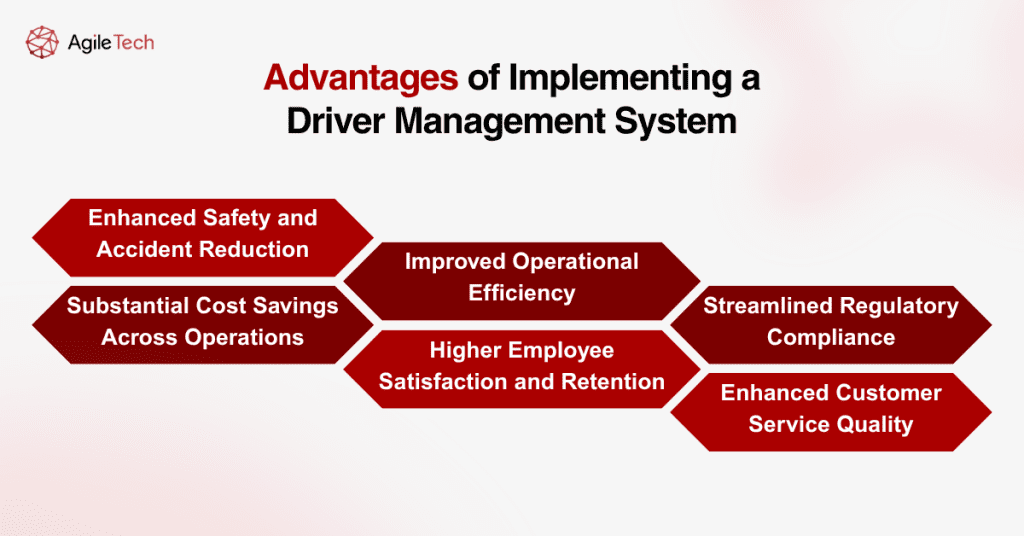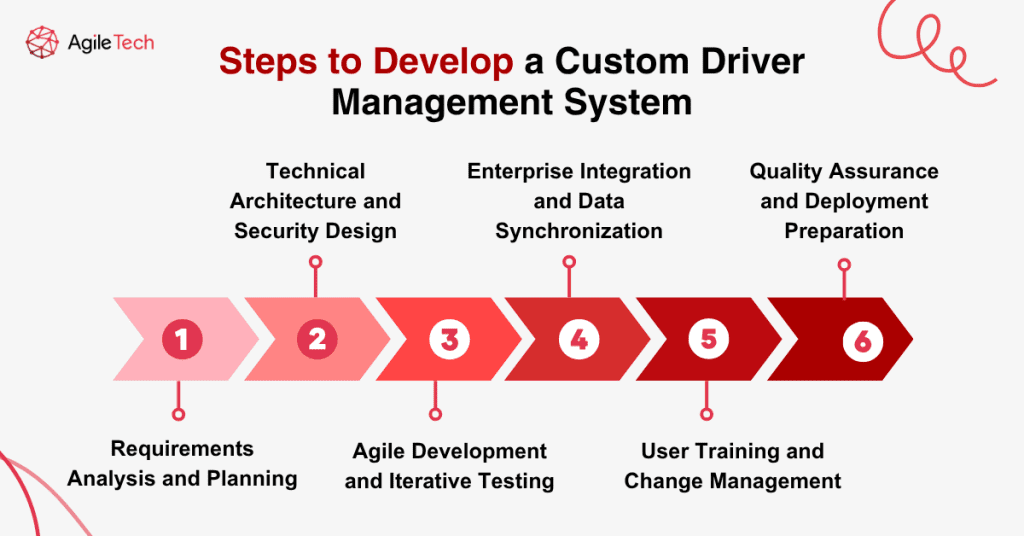The Complete Guide to Driver Management Software: Features, Benefits & Best Practices
Driver management software has become indispensable for modern fleet operations. Designed to streamline driver oversight and enhance safety and compliance, this system empowers businesses with better visibility and control. In this guide, we reveal the essential components, key advantages, and expert practices for successfully implementing a robust driver management solution.

- 1. What is Driver Management Software?
- 2. Core Features of Driver Management Software
- 3. Advantages of Implementing a Driver Management System
- 4. Steps to Develop a Custom Driver Management System
- 5. Driver Management System vs. Fleet Management System: Key Focus Areas
- 6. AgileTech's Specialized Experience in Driver Management System Solutions
1. What is Driver Management Software?
Driver management software is a digital solution used by transportation and logistics companies to track, evaluate, and manage driver activities across their fleets. It centralizes driver records, monitors performance metrics, ensures compliance with regulations, and helps fleet managers maintain high operational standards.
Integrated with telematics and automation tools, driver management systems improve accountability and productivity while reducing risk and operational inefficiencies. Businesses can access real-time data on driver behavior, trip history, violations, and certifications.
Target Users of Fleet Driver Management Solutions
Transportation and Logistics Companies
Fleet driver management solutions serve a diverse range of organizations where driver performance directly correlates with business success and safety outcomes. Transportation companies represent the primary user base, including long-haul trucking operations, regional delivery services, and logistics providers. These organizations typically manage large fleets with hundreds or thousands of drivers across multiple locations, making centralized management essential for operational efficiency.
Construction and Utility Companies
Construction companies frequently implement driver management systems to oversee operators of heavy machinery and commercial vehicles. The specialized nature of construction equipment operation requires enhanced safety monitoring and compliance tracking, making these systems invaluable for risk management. Similarly, utility companies managing field service vehicles benefit from driver management software to ensure technicians arrive safely and efficiently at customer locations.
Public Sector and Emergency Services
Public sector organizations, including municipal fleets, school districts, and government agencies, increasingly adopt driver management solutions to maintain accountability and ensure proper use of taxpayer-funded vehicles. These entities often face additional regulatory requirements and public scrutiny, making comprehensive driver oversight essential for operational transparency.
Emergency services represent another critical user segment, where driver performance can directly impact public safety outcomes. Ambulance services, fire departments, and police agencies utilize driver management systems to optimize response times while maintaining safety standards during high-stress emergency situations.
Tools and Technologies Behind a Driver Management System
Telematics and Real-Time Data Collection
Modern driver management systems leverage a sophisticated array of technologies to deliver comprehensive oversight capabilities. Telematics devices serve as the foundation, providing real-time data collection on vehicle location, speed, acceleration patterns, and driving behaviors. These hardware components communicate with cloud-based platforms through cellular networks, enabling continuous monitoring regardless of geographic location.
AI-Powered Analytics and Pattern Recognition
Artificial intelligence and machine learning algorithms process vast amounts of driving data to identify patterns, predict potential issues, and generate actionable insights. These technologies enable automated scoring systems that evaluate driver performance across multiple parameters, flagging concerning behaviors before they result in incidents or violations.
Mobile Applications and Driver Engagement
Mobile applications extend system functionality directly to drivers, providing real-time feedback, training modules, and communication channels. These apps often include gamification elements that encourage safe driving behaviors through rewards and recognition programs. Additionally, they serve as platforms for reporting incidents, completing safety checklists, and accessing company policies.
Enterprise Integration Capabilities
Integration capabilities represent another crucial technological component, allowing driver management systems to connect with existing enterprise software, including human resources systems, payroll platforms, and compliance management tools. Application programming interfaces enable seamless data exchange between systems, eliminating duplicate data entry and ensuring consistency across organizational platforms.
2. Core Features of Driver Management Software
2.1. Real-Time Behavior Monitoring and Safety Alerts
Contemporary driver management software incorporates a comprehensive suite of features designed to address every aspect of driver oversight and optimization. Real-time behavior monitoring stands as perhaps the most fundamental capability, utilizing telematics data to track speeding, harsh braking, rapid acceleration, and other risky driving behaviors. This continuous monitoring enables immediate intervention when dangerous patterns emerge, significantly reducing accident risk and associated costs.
2.2. Performance Scoring and Analytics Dashboard
Driver scoring and performance analytics provide quantitative assessments of individual and fleet-wide performance metrics. These systems typically generate composite scores based on multiple factors, including safety behaviors, fuel efficiency, on-time performance, and compliance adherence. Management teams can utilize these scores for performance reviews, incentive programs, and targeted coaching initiatives.
2.3. Training Management and Progress Tracking
Training management capabilities enable organizations to deliver consistent, trackable education programs to their driver workforce. Modern systems support various training formats, including online modules, video content, and interactive simulations. Progress tracking ensures all drivers complete the required training while identifying knowledge gaps that require additional attention.

2.4. Automated Compliance Monitoring
Compliance monitoring features help organizations maintain adherence to complex regulatory requirements, including hours of service regulations, vehicle inspection protocols, and driver qualification standards. Automated alerts notify management of pending compliance deadlines while maintaining detailed audit trails for regulatory reporting purposes.
2.5. Integrated Communication and Dispatch Tools
Communication tools facilitate seamless interaction between dispatchers, managers, and drivers through integrated messaging systems, push notifications, and emergency communication channels. These features ensure critical information reaches drivers promptly while maintaining detailed communication logs for operational reference.
2.6. Route Optimization and Assignment Intelligence
Route optimization capabilities analyze driver behavior patterns alongside vehicle and cargo requirements to suggest optimal routing decisions. These systems consider factors including driver experience, performance history, and current workload when making assignment recommendations, maximizing both efficiency and safety outcomes.
3. Advantages of Implementing a Driver Management System
3.1. Enhanced Safety and Accident Reduction
Organizations implementing comprehensive driver management systems experience significant operational improvements across multiple performance dimensions. Safety enhancement represents the most immediate and measurable benefit, with many organizations reporting accident reduction rates of twenty to forty percent following system implementation. This improvement stems from continuous behavior monitoring, immediate feedback provision, and targeted coaching for high-risk drivers.
3.2. Substantial Cost Savings Across Operations
Cost reduction emerges through multiple channels, including reduced insurance premiums, decreased fuel consumption, and lower vehicle maintenance expenses. Insurance providers often offer substantial discounts for fleets utilizing driver management technology, recognizing the correlation between monitoring systems and reduced claim frequency. Fuel savings result from improved driving behaviors, including reduced speeding, smoother acceleration patterns, and optimized routing decisions.
3.3. Improved Operational Efficiency
Operational efficiency gains manifest through enhanced dispatching capabilities, reduced administrative overhead, and improved customer service delivery. Automated reporting eliminates manual data compilation while providing managers with real-time visibility into fleet performance metrics. This transparency enables proactive decision-making and rapid response to emerging operational challenges.

3.4. Higher Employee Satisfaction and Retention
Employee satisfaction improvements occur when driver management systems include recognition programs, fair performance evaluation processes, and opportunities for professional development. Drivers appreciate transparent scoring systems that provide clear pathways for improvement and advancement within their organizations.
3.5. Streamlined Regulatory Compliance
Regulatory compliance becomes significantly more manageable with automated monitoring and reporting capabilities. Organizations can demonstrate due diligence in driver oversight while maintaining comprehensive audit trails that satisfy regulatory requirements. This compliance capability reduces legal exposure and ensures continued operational authorization.
3.6. Enhanced Customer Service Quality
Customer satisfaction enhancements result from improved on-time delivery performance, reduced service disruptions, and enhanced communication capabilities. Customers benefit from real-time delivery updates and more reliable service delivery, leading to stronger business relationships and increased customer retention.
4. Steps to Develop a Custom Driver Management System
Step 1: Requirements Analysis and Planning
Developing a custom driver management system requires careful planning, technical expertise, and a deep understanding of fleet operational requirements. The initial phase involves comprehensive requirements gathering to identify specific organizational needs, existing system integrations, and desired functionality. This analysis should encompass current pain points, regulatory requirements, and growth projections to ensure the system remains viable long-term.
Step 2: Technical Architecture and Security Design
Technical architecture design follows requirements analysis, establishing the foundational structure for data collection, processing, and presentation. This phase determines hardware requirements, communication protocols, database structures, and user interface specifications. Security considerations receive particular attention given the sensitive nature of driver and operational data.
Step 3: Agile Development and Iterative Testing
Development teams typically employ agile methodologies to build driver management systems, allowing for iterative testing and refinement throughout the development process. This approach ensures regular stakeholder feedback while maintaining flexibility to accommodate changing requirements. Core functionality development generally proceeds in phases, beginning with basic monitoring capabilities and progressively adding advanced features.
Step 4: Enterprise Integration and Data Synchronization
Integration planning becomes crucial when connecting driver management systems with existing enterprise applications. This process requires detailed mapping of data flows, authentication protocols, and synchronization requirements. Testing procedures must validate not only system functionality but also integration reliability and data accuracy.
Step 5: User Training and Change Management
User training and change management represent critical success factors often overlooked during development planning. Comprehensive training programs ensure drivers, dispatchers, and managers can effectively utilize system capabilities while change management processes address resistance and adoption challenges.
Step 6: Quality Assurance and Deployment Preparation
Quality assurance procedures validate system reliability, performance, and security before deployment. This testing phase should encompass various operational scenarios, peak usage conditions, and potential failure modes to ensure system stability under real-world conditions.

5. Driver Management System vs. Fleet Management System: Key Focus Areas
While both the driver management system and fleet management system share technological foundations, their optimization targets and core functionalities differ significantly. Understanding these differences helps organizations choose the right solution for their specific needs.
| Aspect | Driver Management System | Fleet Management System |
|---|---|---|
| Primary Focus | Human capital optimization and driver performance | Vehicle operations and asset management |
| Core Objective | Driver behavior modification, safety, and training | Vehicle maintenance, fuel efficiency, and asset utilization |
| Data Collection | Driver behavior patterns, compliance adherence, performance metrics | Vehicle telemetry, engine performance, and maintenance requirements |
| Key Features | – Real-time behavior monitoring – Driver scoring and coaching – Training management – Compliance tracking | – Vehicle tracking and routing – Maintenance scheduling – Fuel management – Asset utilization |
| Reporting Focus | Individual performance metrics, safety scores, and training completion | Vehicle-focused dashboards, maintenance schedules, and fuel consumption |
| Integration Partners | HR systems, training platforms, and compliance tools | Maintenance systems, fuel card platforms, route optimization tools |
| Target Users | Fleet managers, safety directors, and HR departments | Operations managers, maintenance teams, and dispatchers |
| ROI Measurement | Accident reduction, driver retention, and safety compliance | Vehicle uptime, fuel savings, and maintenance cost reduction |
6. AgileTech’s Specialized Experience in Driver Management System Solutions
At AgileTech, we bring years of experience in building intelligent transport solutions, including custom driver management systems tailored for logistics and fleet-heavy industries.
Our team leverages cutting-edge technologies such as IoT, cloud computing, and AI-powered analytics to create scalable, secure, and user-friendly platforms. Here are some key highlights of our service capabilities:
- Custom software development based on your operational workflows and compliance landscape
- Integration-ready platforms with support for third-party telematics, HR, payroll, and regulatory databases
- Real-time dashboards providing full visibility into driver KPIs and incident reporting
- Mobile-first approach ensuring an intuitive user experience across devices
- Data security and compliance with GDPR, HIPAA, and regional transport data laws
One notable case is our GPS Tracking Software project that incorporates driver tracking software for a large-scale Fleet Management System. AgileTech implemented a robust driver monitoring module that included:
- Real-time driver behavior tracking through integrated GPS and telematics
- Violation alerts such as speeding, sharp turns, and sudden braking
- Dynamic driver scorecards to benchmark and improve performance over time
- Comprehensive analytics dashboard for actionable insights into driver activity
This solution not only improved road safety and operational compliance but also empowered managers with better decision-making tools. Whether you’re building from scratch or modernizing an outdated system, AgileTech helps businesses harness the full potential of driver management software to unlock new levels of safety, efficiency, and growth.